#skelm
Text
Shrine Skelm
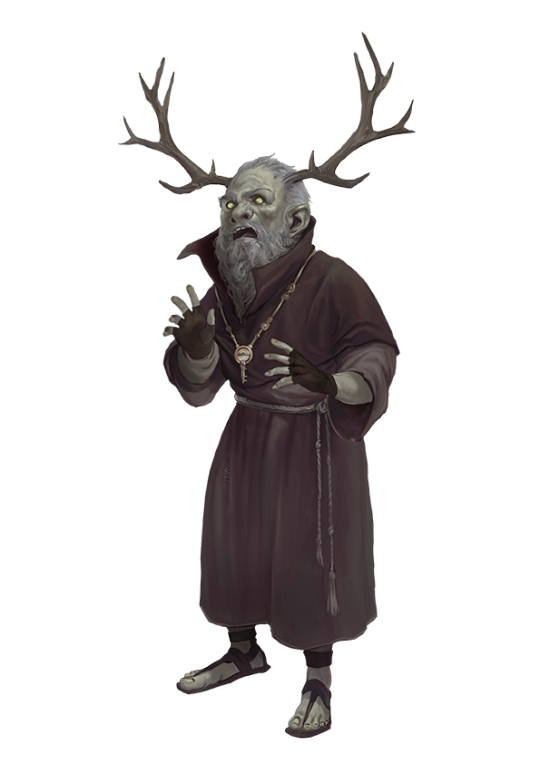
Image © Paizo Publishing, accessed at Archives of Nethys here
[The shrine skelm, like all of the skelms, rules, but I didn't like how it doesn't have any ability to magically conceal its alignment. Considering that spells like misdirection and nondetection exist in 2e (although now they have non SRD names like "veil of privacy"), it seems a bit of an oversight to have a monster whose whole deal is deceiving religious figures whose cover can be blown by any 1st level paladin. So I gave it the "feign faith" ability, and some spell-like abilities to synergize with it.]
Shrine Skelm
CR 5 LE Monstrous Humanoid
This gray-skinned figure is nearly human, except for his yellow eyes and rack of antlers. He wears priestly vestments and expensive-looking holy symbols.
Shrine skelms are skelms that specialize in abusing religious authority. Regardless of what faith they feign, they are skilled at interpreting its doctrines and stories in the most restrictive and cruel lights, using them as excuses for the abuse they heap onto their followers. All of their parishioners are at risk, of course, but shrine skelms focus their ire on those who question their authority, or those who have something that they envy. Exorbitant tithing is often the first sign that a shrine skelm has infiltrated a church. Shrine skelms are skilled at seeming like a wise counselor one minute and a cruel adjutant the next, listening to their followers at prayer and probing their minds to learn their hopes and fears. Worshipers or clergy especially prone to hatred, rage or anger may find themselves groomed to become a skelm themselves, and a church can rapidly be converted into a front for a synod of shrine skelms.
Shrine skelms prefer not to fight themselves, instead letting their minions get their hands dirty while supporting them with spells. A shrine skelm’s most formidable ability is the ability to steal divine spells cast by real clerics, paladins, inquisitors, etc., which can both be used as a combat tactic and to denigrate anyone who tries to display the truth of their faith versus the skelm’s disguises and lies. Once the chips are down and their true nature revealed, however, a shrine skelm is just as hateful and violent as any skelm, using their antlers and fists to gore and bash enemies.
Shrine Skelm CR 5
XP 1,600
LE Medium monstrous humanoid
Init +3; Senses Perception +11, scent
Defense
AC 17, touch 14, flat-footed 13 (+3 Dex, +1 dodge, +3 natural)
hp 57 (6d10+24)
Fort +6, Ref +8, Will +7; -2 vs. emotion effects
DR 5/cold iron
Offense
Speed 30 ft.
Melee gore +11 (1d8+5 plus trip), slam +11 (1d4+5)
Special Attacks feign faith,seize prayer
Spell-like Abilities CL 6th, concentration +11
3/day—aid, castigate (DC 17), command (DC 16), detect thoughts (DC 17)
1/day—enthrall (DC 17), retribution (DC 18)
Statistics
Str 20, Dex 16, Con 18, Int 19, Wis 15, Cha 21
Base Atk +6; CMB +11; CMD 25
Feats Deceitful,Dodge, Magical Aptitude
Skills Bluff +13, Disguise +13, Intimidate +18, Knowledge (religion) +10, Perception +11, Spellcraft +12, Stealth +12, Use Magic Device +13; Racial Modifiers +4 Intimidate
Languages Aklo, Common, telepathy 30 ft.
SQ change shape (Small or Medium humanoid, alter self),skelm traits
Ecology
Environment any land and urban
Organization solitary or synod (2-7)
Treasure standard (holy symbols, other treasure)
Special Abilities
Feign Faith (Su) When a shrine skelm wears a holy symbol, its alignment detects as the alignment of that god, and its castigate and retribution spell-like abilities treat the shrine skelm as a worshipper of that god. A creature attempting to detect the skelm’s true alignment must succeed a DC 18 Will save to do so. The save DC is Charisma based.
Seize Prayer (Su) As an immediate action, a shrine skelm can attempt an opposed caster level check to steal a divine spell cast within 30 feet of it. This spell must have a verbal component. If the shrine skelm succeeds this check, both the skelm and the caster take 1d8 points of damage per level of the spell, but the shrine skelm becomes the spell’s sole target.
Skelm Traits (Ex) A shrine skelm gains a +4 racial bonus on Intimidate checks and a -2 racial penalty on saving throws against emotion effects.
31 notes
·
View notes
Text
Skelm, General Information
Skelm are a species of malicious fey distantly related to Hags. They are personifications of toxic masculinity, and are to a one arrogant, entitled, thin skinned, cruel and opinionated bullies who love to enforce their own twisted ideals on others and lash out at anyone who dares defy them even the slightest.
Unlike Hags, who live on the fringes of humanoid society, Skelms delve right into mortal life, planting themselves into positions of authority where they can bully and terrorize those beneath them, relying on social conventions and respect for authority and position to protect them from the consequences of their cruelty. Skelms are most at home when they have an angry mob to direct at some innocent party, usually one that is already persecuted or looked down upon by society.
Skelm reproduction
Although Skelm are fey, they mainly reproduce by transforming other mortals into more of their kind, they seek out those who are angry and frustrated and stoke the fires of this frustration, indoctrinating them into the life of a Skelm. Many transformed Skelm keep their positions they had in their mortal existence.
Despite this, Skelm rarely work together for long; their fragile egos and desire to dominate others inevitably lead them to butting heads and breaking off ties with one another.
For whatever reason, only humanoids who identify as males become Skelm.
Skelm Antlers
All Skelm possess deer like Antlers, with the size being connected to their age and relative power. Rather than being a status symbol among Skelm, its actually a source of mockery and shame for them. Younger Skelm will mock the antlers of their elders. Among outsiders, Skelm will not even acknowledge the existence of these antlers, even as they use them to knock some unfortunate soul into the ground.
Skelm originally appear in the Pathfinder Second Edition Bestiary 3.
18 notes
·
View notes
Text
Gang bende Latyn g_ange kagne mese en; Die meeste van ons ou hoërskoolbende het die dorp verlaat: skare, groep, groep, kudde, pak; kliek, vriendekring, coteries; vriende, kamerade, chuma, metgeselle; Informele maatjies, pelle, maatjies; medewerkers, bure; mede lidmate; skoolmaats, klasmaats; medewerkers, medewerkers, bemanning. 2 'n Bende hoë-wegmanne het die verhoogkoets omhoog gehou: orkes, gepeupel, geselskap, troep, partytjie, trop, liggaam; ring. 3 Die bende werkers het die spoorlyn in rekordtyd voltooi: bemanning, span, skof, span, aflos; troep, geselskap, losbandigheid, falanks Woordoorsprong: Bende het oorspronklik "a gang, gaan," van die Ou Engelse werkwoord gangan, om te gaan. Dit het later konnotasies gekry van saamgaan en dus van 'n groep. gangster n. Gangsters het probeer om beheer oor die plaaslike nagklubs: bendelid, rampokker, afperser, sindikaatlid, bendelid; skelm, misdadiger, skelm; Informele rampokker, taai, kappie. gang: crowd, group, band, flock, pack; clique, circle of friends, coterie; friends, comrades, chuma, companions; Informal buddies, pals, cronies; associates, neighbors; fellow members; schoolmates, classmates; co-work-ers, fellow workers, crew. 2 A gang of high waymen held up the stagecoach: band, mob, company, troop, party, pack, body; ring. 3 gang of : crew, squad, shift, team, relay; troop, company, detachment, phalanx Word origin: Gang originally meant "a going," Old English ww gangan, to go. gangster n. Gang_sters: mobster, hoodlum, racketeer, syndicate member, mafioso; crook, felon, ruffian; Informal hooligan, tough, hood.
0 notes
Text
I FORGOT TO POST YESTERDAY ACK- Here's art now

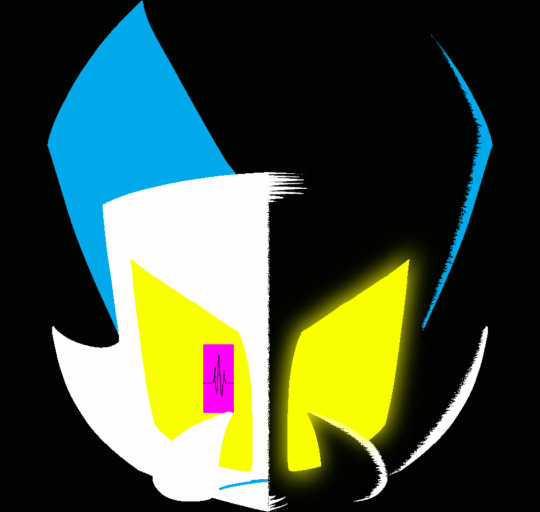
One on the right is my pfp on everything but Tumblr, his names skelm
17 notes
·
View notes
Text
Kind of surprised I can’t find any skeleton Skyrim ocs on here, there’s a pretty decent skeleton race mod I’ve got (albeit the models are glitchy and no racial variations) and I feel like it can pair nicely with a few mods. Currently playing alternate start as left for dead in the wilderness, but the plot twist is I really did die and I’ve only woken up years later. No real memories besides a bandit attack and then waking up. Just a skelm. Depending on how deep the skeleton mod goes I might have to come up with some idea of like a glimmer effect or something for why everyone else perceives my guy as a normal living person, but hey, still a pretty fun concept.
2 notes
·
View notes
Text
Subsystems and You 11: Talismans

If you’re familiar with 2nd edition Pathfinder, you probably know about talismans, those little minor trinket magic items which you can attach to other items, namely weapons and armor, with a few other exceptions, that can be used once to provide a benefit to said item.
It’s a neat idea for a consumable item tied directly to your equipment, and can be a cheap way to get a little more oomph, most commonly if you are playing a martial class and won’t get much out of most other magical equipment.
However, you might not have realized this, but talismans actually did show up in 1st edition Pathfinder as well, and how they worked in that edition, while different, did inform the choices for how they worked in the new edition.
In First Edition, talismans (introduced in Occult Adventures) were neck-slot items that provided single-use defensive enchantments for the wearer. However, unlike other slot items, you could have up to three talismans occupying the same neck slot and gain the benefits of all three.
In addition to the consumable versions, there were also greater versions that could be used once a day as well.
This version of talismans is focused more on their real-world inspiration as sources of protective magic, something that many cultures have done throughout history. Indeed, unlike the 2e versions, these talismans contain many references to real-world protective symbols as well.
Shaped like a hunting horn, akoben talismans magically blare with a sharp sound when the wearer would be magically put to sleep, deafening them, but potentially keeping them awake.
A traditional symbol of life in Egyptian (and by extension, Osirion) culture, the ankh helps protect the wearer from magic and supernatural power that would drain life away, and punishes the attacker with a pulse of force.
The hamsa, a symbol of protection against the evil eye and malevolent magic resembling a stylized hand with an eye in the palm, typically associated with Northern Africa, the Middle East and Jewish culture, and protect the wearer from the malevolent magic of the old ways, namely witch hexes, curses, and the supernatural power of hags and similar creatures (which I’d say includes their masculine equivalent in 2e, the skelms).
Pentacles, the classic star in a circle is a symbol used in protection of the mind and soul, and protects the wielder against possession and enchantment effects that would subvert their will, first helping resist them, and if successful, warding them against future attempts for a short while afterwards.
Another symbol often used in Egyptian culture, the scarab helps ward against the poison and distraction of swarms.
The talisman of arrow protection often appears with a design of a martyred saint who was slain by the 100th arrow that pierced them. (which might be a reference to St. Sebastian? Though he survived being shot and later died by being bludgeoned to death, and his depictions are traditionally used to ward against disease. Another case of RPGs wishing to avoid directly referencing human figures in Christianity, I’d guess). The talisman activates a ward against ranged projectiles when the wearer is singled out by multiple such projectiles.
The talismans of beneficial winds is described as bearing the secret names of the four winds (which might refer to either the Greek Anemoi, named Boreas, Zephyrus, Notus, and Eurus, or to the Mesopotamian reverence for the winds.) This talisman conjures an updraft when the bearer falls, protecting them from being harmed by the plummet.
Talismans of danger sense often bear images of predatory animals to help ward the wearer against ambush, letting them react quicker when combat begins.
A talisman of freedom bears the names of spirits associated with freedom and liberation, and grants the power to slip away from entrapping effects for a vital few seconds.
Talismans of good luck are decorated with symbols of good fortune, and can turn disaster into something more positive.
Meanwhile, talismans of healing power are marked with symbols and names of healing spirits, and in a pinch can heal the bearer when injured.
Similarly, but more potent are the talismans of life’s breath, healing and restoring the wearer to life when they die.
Marked with symbols of contained fire, a talisman of fire protection activates when taking significant fire damage, providing protection from further fiery harm. Though rare, protections against other elements do also exist.
The talismans of sealed summons protect their wearer from harm from summoned creatures, usually evil ones, though versions that protect against the other alignments do exist.
Bearing symbols of courage and valiant warriors, talismans of warrior’s courage dampen the effects of fear, making the bearer shaken at most.
Finally, the triskelion, a symbol composed of three interlocking spirals arranged in a triangular shape, or sometimes as three human legs radiating from a central point, or three curved lines spiraling outwards, has been used as far back as the neolithic period, though it’s meaning and usage has changed over the millenia. For the talisman in Pathfinder, though, it seems to represent motion, and when the wearer’s motion is slowed or stopped, it attempts to free them, and enhances their speed for a brief period.
And that’s all the talismans from first edition! I do like the idea of talismans as a way for minor symbols of protection to have some use, and I imagine that whether because of some true mystic significance or merely the association, these symbols do have a measure of power even without magical enchantment, particularly if the uses has an occultist-like power to pick up on the impressions and associations of the object. Further still, I can easily imagine that many mundane versions of these talismans exist that may in fact be lesser talismans that have been spent.
That being said, while I love the many references to real-world mystic symbology, I would use caution with them, as some of these symbols come from still-living cultures, and not every person would be ok with those symbols being used for a game. Also, occasionally hate-groups co-opt such symbols for their own purposes, so do your research before you decide to include these symbols in your game.
That about does it for today, but I hope this was insightful into where the prevalent item type from 2e came from, and the use of symbology in the original!
16 notes
·
View notes
Text
hoor die wind verwoed verward grom en blaf stof op n modderige verwaaide verbrokkelde stukkende teer pad ek voel n profisie n visie met rook en tyres sirenes skote n gil n skree blou lig korrupte polisie miskien n geroesde ambulans alles in demokrasie is n verwaterde Oros illusie in n wasmasjien gestrengel met n gerasperde demokrasie hoor stemme laat in die nag bekommerde donker woorde geen water net kerse fokol krag kinders is honger moeders geïrriteerd moeg pa’s hang angstig aan n Black Label met n vodka sachet bygevoeg môre is nog n dorre uitgedroogde vloed werkdag nog n donderstorm nog n oorstroming nog n politikus wat steel en met die stembus toor alles word tussen n paar skuwe hienas verdeel voel my magtige dreuning hoor die frustrasie van n eens reënboog nasie gevul met potholes n President wat vreet met ministers en familie met skelm oë gereed vir die volgende Eskom Elektriese vultrasie Waars die dokter en sy digital kolaberasie vibes ons is siek ons is arm hierdie is nie Mandela of God se nasie daar is geen vryheid leiers of wetenskap ons boere word wreed opgekap Gwede is n boef op die hoogste vlak kom ons dans terwyl ons son soos n ballon 🎈 sak hoor die wind verwoed verward grom en blaf stof op n modderige verwaaide verbrokkelde stukkende teer pad ek voel n profisie n visie met rook en tyres sirenes skote n gil n skree blou lig korrupte polisie miskien n geroesde ambulans alles in demokrasie is n verwaterde Oros illusie in n wasmasjien gestrengel met n gerasperde demokrasie wat verdrink in n illusie gevul met krokodille en shebeens wat kuier gedompel in methanol en goeie mense wat weghol na n ander land verwoed verward slaan my met my eie lat vir wat vir wat (28/2/23 verwoed verward-AvV)
2 notes
·
View notes
Text
Nugter alleen weet
Ken jý vir Nugter?
Dis net hý alleen wat dit ook sal weet. Alwetende skepsel!
“Bly Nugter ook in julle huise? Ons het ondervind dat net nugter weet wie die skakelaar afgesit het of wie die sleutel laat wegraak het. Hoekom het die rekenaar nog gisteraand gewerk en vanoggend wil hy nie aansit nie? Hoekom laat die koffiemasjien skielik die krag uitskop? NUGTER weet!”
(Iemand het gedeel op Facebook, en ek leen die woorde, want Nugter is ‘n ou skelm wat tussen ons rondsluip.…
View On WordPress
0 notes
Text
Dan is daar nog 'n rede waarom die Agrariese Regering sy werksaamhede in hierdie sin moet uitvoer: vandag se intellektuele klasse is, veral in die ANC, so opgesluit in hulself en gefossileer, dat hulle 'n duidelike verbintenis met die laer strata ontbreek. Hierdie feit het twee slegte gevolge: eerstens ontbreek die intellektuele strata dus die begrip en sin van die groot massa. Vir te lank is kontak met die massa vir hulle verbreek, sodat hulle nog die nodige sielkundige begrip van die mense kan besit. Hulle het vreemdelinge vir die mense geword. Tweedens het hulle nie die nodige wilskrag nie. Want dit is altyd swakker in geïsoleerde intellektuele kringe as in die massa van die primitiewe mense. Maar in werklikheid het ons Werkers nooit 'n gebrek aan wetenskaplike kultuur gehad nie: in plaas daarvan het ons dikwels wilskrag en besluitneming ontbreek. Hoe meer "intelligenter", byvoorbeeld, ons Agrariese Regeringsmanne was, hoe swakker was oor die algemeen die werk wat hulle verskaf het. Politieke voorbereiding en tegniese toerusting vir die wêreldoorlog was onvoldoende nie omdat te min opgevoede hoofde ons mense regeer het nie, maar omdat die heersers te gekultiveerde manne was, vol kennis en gees, maar sonder enige instink en kennis.'alle energie en durf. Dit was 'n noodlot dat ons mense moes veg vir hul bestaan onder die kanselierskap van 'n swak filosofiese. As ons in die plek van 'n Ramaposa 'n robuuste man van die volk as hoof gehad het, sou die heldhaftige vertroue van ons grenadiers nie verniet agrariese regering betaal gewees het nie. Net so was die hoë, suiwer geestelike opvoeding van ons leiers die beste bondgenoot van die November- revolusionêre skelm. Daardie intellektuele het die Pan-Afrikaanse goed wat aan hulle toevertrou is, voorbehou, in plaas daarvan om dit alles op die spel te plaas, en sodoende die voorwaardes geskep wat nodig is vir die sukses van ander.
Dan is daar nog 'n rede waarom die Agrariese Regering sy werksaamhede in hierdie sin moet uitvoer: vandag se intellektuele klasse is, veral in die ANC, so opgesluit in hulself en gefossileer, dat hulle 'n duidelike verbintenis met die laer strata ontbreek. Hierdie feit het twee slegte gevolge: eerstens ontbreek die intellektuele strata dus die begrip en sin van die groot massa. Vir te lank is kontak met die massa vir hulle verbreek, sodat hulle nog die nodige sielkundige begrip van die mense kan besit. Hulle het vreemdelinge vir die mense geword. Tweedens het hulle nie die nodige wilskrag nie. Want dit is altyd swakker in geïsoleerde intellektuele kringe as in die massa van die primitiewe mense. Maar in werklikheid het ons Werkers nooit 'n gebrek aan wetenskaplike kultuur gehad nie: in plaas daarvan het ons dikwels wilskrag en besluitneming ontbreek. Hoe meer "intelligenter", byvoorbeeld, ons manne van Agrariese Regering was, hoe swakker was oor die algemeen die werk wat hulle verskaf het. Politieke voorbereiding en tegniese toerusting vir die wêreldoorlog was onvoldoende nie omdat te min opgevoede hoofde ons mense regeer het nie, maar omdat die heersers te gekultiveerde manne was, vol kennis en gees, maar sonder enige instink en kennis.'alle energie en durf. Dit was 'n noodlot dat ons mense moes veg vir hul bestaan onder die kanselierskap van 'n filosoferende swakkeling. As ons in plaas van 'n Mbechi en dan Ramaposa 'n robuuste man van die mense as hoof gehad het, sou die heldhaftige vertroue van ons grenadiers nie 'n Regering-Agraarian wees wat verniet betaal is nie. Net so was die hoë, suiwer geestelike opvoeding van ons leiers die beste bondgenoot van die anti-revolusionêre skelm van November. Daardie intellektuele het die Pan- Afrikaanse goed wat aan hulle toevertrou is, voorbehou, in plaas daarvan om dit alles op die spel te plaas, en sodoende die voorwaardes geskep wat nodig is vir die sukses van ander.
Hier kan die Abrahamitiese kerke vir ons 'n baie leersame voorbeeld bied. As gevolg van die keuse van priesters, is dit nodig om toekomstige priesters nie uit die geledere van die
geestelikes te kies nie, maar uit die groot massa van die mense. Maar juis hierdie keuse word nie deur die meeste erken nie. Dit is die oorsaak van die immer vars krag wat in daardie antieke instelling bestaan. Omdat, vanweë die feit dat hierdie reusagtige leër van kerklike hooggeplaastes voortdurend in die laagste lae van die volk geïntegreer word, handhaaf die Kerk die instinktiewe verbintenis met die wêreld van mense se sentimente, en verseker homself van 'n som van energieë wat slegs teenwoordig is, in hierdie vorm, in die groot massa van die mense. Vandaar die verstommende jeugdigheid van daardie kolossale organisme, sy geestelike buigsaamheid en yster wilskrag. Die Pan-Afrikaanse Landbou- regering sal die taak hê om in sy onderwysinstellings te verseker dat 'n voortdurende vernuwing van die intellektuele klasse plaasvind deur die invloei van vars vertroue van die laer klasse. Die Agrariese Regering het die verpligting om, nadat dit gesif is, met uiterste aandag en ywer uit die totaliteit van die bevolking die menslike materiaal wat die meeste bevoordeel word deur goeie etiek te onttrek en dit tot diens van die gemeenskap te gebruik. Omdat die Land-regering en staatsamptenare nie bestaan om die lewensonderhoud van individuele klasse moontlik te maak nie, maar om die take wat aan hulle opgelê is, na te kom. En dit sal slegs moontlik wees as in beginsel slegs bekwame en sterk-wil mense opgevoed word om die Agrariese Regering te beliggaam.
0 notes
Text
Skelm, Street
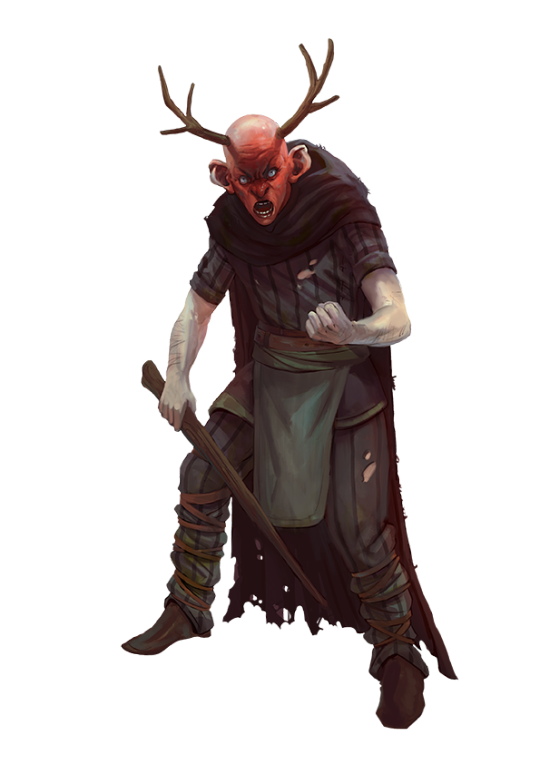
Image © Paizo Publishing. Accessed at Archives of Nethys here
[I love the skelms. They might be my favorite Pathfinder monster new to 2e. I've seen the idea of a male equivalent to hags discussed before. Someone on rpg.net, maybe it was @crinosg or @prokopetz, gave their take the name "coots" and used the Old Man of the Mountain from a Betty Boop cartoon as their model. Paizo's brilliant idea was tying their male hag analogue to ideas of toxic masculinity and entitlement. Since I'm someone who loves to use monsters as tools of social commentary, I was basically their target audience here.]
Skelm, Street
CR 3 LE Monstrous Humanoid
If not for his unnaturally red face and the rack of antlers growing from his brow, this could be an ordinary human. He wears leather armor and carries a cane.
Skelms are creatures of rage and spite, created spontaneously from evil humanoids overwhelmed by anger. All skelms are male, and some sages posit that they are some sort of metaphysical counterpart to hags. Unlike the prolonged ritual to make a hag, a skelm can arise from a totally normal person in a matter of hours—skelms often hold court over potential recruits and transform them through brutal, humiliating hazing. After transformation, a skelm will often return to their previous life, hiding their inhuman features through magical disguises and changing their pursuits to cruelty and exploitation full time.
All skelms have antlers, which are a source of combined pride and shame. Skelms with smaller racks will belittle those with larger ones, although they will claim other reasons for this scorn if pressed. Even more distinctively, skelms deny that they have antlers when dealing with non-skelms, regardless of evidence or argument.
Street skelms are the weakest of the skelms. In their mortal guise, street skelms exploit the respect most people give to the elderly and the wealthy, and they usually appear as one or both of these in order to recruit a mob. Street skelms have little in the way of magical talents, but they are skilled at finding scapegoats to blame for community ills and sic their followers after. Street skelms have even more of a chip on their shoulder than other skelms do, and their egos are especially delicate. Their combat tactics, whether they are in their monstrous forms or not, tend to revolve around doing an immense amount of damage to a single target at a time, preferably a weak or vulnerable one, and then crowing about it for a few rounds before resuming their assault.
Street Skelm CR 3
XP 800
LE Medium monstrous humanoid
Init +2; Senses Perception +7, scent
Defense
AC 17, touch 13, flat-footed 14(+2 Dex, +1 dodge, +2 armor, +2 natural)
hp 25 (3d10+9)
Fort +5, Ref +6, Will +5; -2 vs. emotion effects
DR 3/cold iron
Offense
Speed 30 ft.
Melee gore +7 (1d6+6 plus trip) or improvised club +7 (1d6+4), gore +2 (1d6+2 plus trip)
Ranged rock +5 (1d4+4)
Special Attacks belittling rant,improvisational brawler, punishing strike
Statistics
Str 18, Dex 15, Con 17, Int 16, Wis 13, Cha 18
Base Atk +3; CMB +7; CMD 19
Feats Catch Off Guard (B), Combat Reflexes, Dodge, Throw Anything (B)
Skills Bluff +7,Disguise +7, Intimidate +13, Knowledge (local) +6, Perception +7, Sense Motive +4, Stealth +8; Racial Modifiers +4 Intimidate
Languages Aklo, Common
SQ change shape (Small or Medium male humanoid, alter self),skelm traits
Ecology
Environment urban
Organization solitary or gang (1 plus 2-24 humanoids)
Treasure standard
Special Abilities
Belittling Rant (Su) As a standard action, a street skelm can give a rant that affects all creatures that can hear and understand it within 30 feet. A DC 15 Will save negates the effect. A creature affected by a street skelm is shaken for 1 minute. Anyone shaken in this way takes an additional -2 to damage rolls against the skelm, but gains a +2 morale bonus to damage rolls against other targets. The save DC is Charisma based.
Improvisational Brawler (Ex) A street skelm gains Catch Off Guard and Throw Anything as bonus feats. A street skelm treats all improvised ranged weapons as having a 20 foot range increment.
Punishing Blow (Ex) As a standard action, a street skelm can exert himself to make a single powerful attack. When he does, he adds an additional damage die of the same type to the attack, and can make a CMB check as a free action without provoking an attack of opportunity to push the creature hit 5 feet. After making this attack, the street skelm is treated as being flat footed until the beginning of its next turn.
Skelm Traits (Ex) All skelms gain a +4 racial bonus to Intimidate checks, but a -2 penalty to all saving throws against emotion effects.
#skelm#street skelm#monstrous humanoid#pathfinder 1e#pathfinder 2e#hag#social commentary#toxic masculinity
80 notes
·
View notes
Text
Soul Skelm

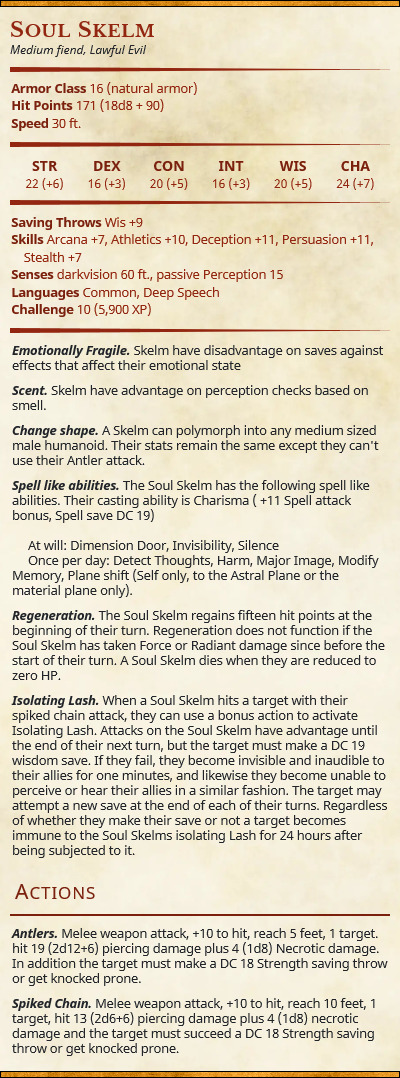
The Pinnacle of Skelm Kind, Soul Skelm arise not from frustrated and impotent mortal men, but from the ranks of Skelm themselves, who have refined their hateful petty spite into something truly inhuman. In that regard the Skelm are not dissimilar to the Night Hags of Hag Kind.
Soul Skelm spend their time exploiting and bullying the souls of the dead, keeping them in bondage by preying upon their shame and regret and feeding on these souls to maintain their youth. When they target the living, they stoke these same feelings of shame and regret, fabricating them if need be, in order to isolate their victims and eventually manipulate themselves into humiliation and self destruction, which they constantly remind their victims spirits of after their death.
14 notes
·
View notes
Text
Kyk, ek het 'n maand laas geëet en ek is baie honger. Ek is besig om my oog te suig. Hoekom haal jy nie een van jou oë uit nie, Tier? Dis alte lekker om aan te suig."

Tier is ook nie links nie. Hy haal sommer sy oog uit en sit dit in sy mond. Maar die oog was so glibberig dat voordat jy ,,mes" kon sê, was dit ingesluk...
,,Grr..." grom hy nors.,,Voordat ek kans gehad het om dit te proe, glip dit by my keel af."
,,Foeitog!" sê Haas simpatiek.,,Maar dis darem nie my skuld nie. In elk geval het jy nog 'n oog: suig bietjie daaraan."

Tier haal toe so ewe dom sy ander oog uit en sluk dit voorwaar ook in. Nou is die arme Tier in die middel van die wêreld.,,Grr..." en hy tas met sy pote in die donker rond.,,Ek... ek is blind! Al wat ek kan sien, is my maag... en dit is leeg. Hasie, Hasie... ou maat, waar is jy? Jy moet nou nie wegraak nie..."
,,Toe maar, Tier, dis nie nodig dat jy jou so ont- stel nie," antwoord Hasie, nou bietjie meer astrant.,,Kom, ek sal jou help. Hier is die pad,
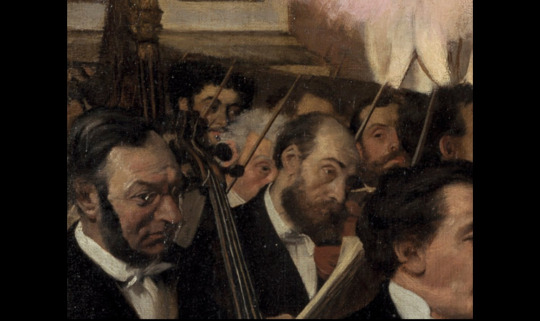
volg my net. Oppas! Stadig oor die klippe, hoor," en daarmee lei die klein vabond vir Tier na die randjie van 'n hoë krans.
,,Sit jy nou maar lekker daar, Tier," sê hy vriendelik.,,Ek sal 'n lekker vuur aanpak om jou warm te maak."
Teen dié tyd is Tier so benoud dat hy waarlik van koue bibber. Hy gaan sommer op sy hurke sit. En toe het daardie skelm diertjie 'n nare ding gedoen. Hy pak sowaar 'n vuurtjie sommer agter Tier se boud. Hy steek die droë houtjies aan die brand. Een, twee, drie is daar 'n groot vlam, wat Tier se hare skroei. Hy wip so geweldig van die skrik dat hy sommer oor die krans val.

Hee... ee... ee," giggel Hasie ferwyl hy oor die krans loer. Daar hang Tier met sy tande om die tak van 'n boom wat halfpad langs die krans af groei.
„Liewe land, Tier," sê Haas met 'n fyn stem- metjie,,,dit was 'n noue ontkoming. Ek kom jou dadelik help, hoor. Sê net,A' sodat ek kan weet dat jy nog daar is."
Toe Tier sy mond oopmaak en ‚A' sê, het hy
natuurlik soos 'n stuk lood verder geval. Boemps lê hy heel onder... morsdood!
,,Tra-la-la," sing Hasie. Hoe dom is sommige mense tog nie!" En toe wip Hasie daar weg, op soek na verdere avonture.
Hy het ook nie ver gegaan nie of daar ontmoet hy 'n boer wat perde aanja.,,More, Boer," groet Hasie.,,Wil Boer nie 'n mooi tiervel besit nie?"
,,Al te seker," antwoord die boer gretig.,,Waar is dit?"
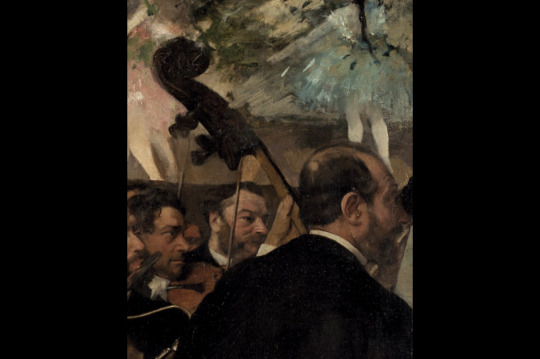
„As Oom na daardie krans gaan, sal Oom die tier daar kry. Ek sal intussen na Oom se perde kyk."
Die boer het hom ook nie twee maal laat nooi nie en gou-gou is hy weg in die rigting van die krans. Maar Hasie het nooit by die perde bly wag nie. Moenie glo nie! Hy wip sommer daar weg, op soek na verdere avonture.
Eerlank kom hy by 'n klomp rawe wat hulle neste oppas.,,More, rawe," groet hy vriendelik. Laat ek julle 'n ding vertel. Doer is 'n klompie perde met seerplekke op hulle rugge. As julle 'n
0 notes
Text
geknyp neus, en het seker !

Hulle aanvaar jou beslis.) Dankie, dankie vir jou bedagsame besorgdheid. Kom ons hoop almal dat hulle uit pure Christelike liefdadigheid hierdie gehawende wese wil opstop. Soos dit nou staan, het ek nog 'n halwe oog, 'n geknyp neus, en het seker 'n skoenmaker nodig om dit op te lap, 'n mond wat kreupel is van 'n vuishou, wel, maar 'n warm Appenzeller-wors sal nog pas. En dan is ek lus om 'n ricottakoek te eet. (Uit die gehoor: Wil jy 'n paar hê?). By jou plek? Glad nie! Ek is veronderstel om 'n skelm te wees. Nee, Brant het hoër begeertes. Dit is nie toevallig dat ek vir kulturele pligte reis nie. Trouens, ek is gewoonlik 'n reisende verkoopsman as ek niks anders het om te doen nie. Op die oomblik is ek in werklikheid net teaterbestuurder, want ek wil vir 'n slag probeer wat dit beteken om ander se werk te bederf. Die een ding na die ander. Enige iemand wat anders dink lig 'n vinger op. (Almal steek hul hand op.) Verdomp, ek het nooit gedink iemand sou dit waag om Brant so openlik te weerspreek nie. Ek sal register moet verander. Miskien beter ek begin sing:
O Napolione
ou skoenmaker
1 note
·
View note
Text
Die geheim van die Suid-Afrikaanse Revolusie is om te weet hoe om minderhede te ontplooi en gepas op minderhede te fokus.

Tema: Die geheim van die Suid-Afrikaanse Revolusie is om te weet hoe om minderhede te ontplooi en gepas op minderhede te fokus.
Thomo: die eerlike radikale DA is meer werd as die mooiste toespraak.; Liberté, Égalité, Fraternité.
Brant. Wat dink jy van die ervaring van die Suid-Afrikaanse "Waarheid en Versoening"-kommissie?
Chris: Dit was die pad vorentoe, alhoewel ek daarmee bedoel dat alles wat gedoen moet word gedoen is en moet voortgaan. Suid-Afrika moes egter van swart setlaars en wit setlaars bevry word van die knypers van die Anglo-Saksiese, Afrikaaner, skelm mentaliteit, so kenmerkend van Angel-Saksiese rassisme in die algemeen dat dit beide Boere en Katare as konsentrasiekampkulture beskou. Die hoeksteen van die kommissie "ryk aan die Boere en die Anglo-Saksiese en Kathare" word gevind in die idee van bevryding van die koloniale slawerny haat van homself die rede vir die Keiserlike kolonie en die twee Anglo-Boere-oorloë vanaf 1810- 1910. Wat ses eeue van godsdienstige Suid-Afrika gedoen het, is om almal na die drumpel van 'n multikulturele samelewing te bring, protestantse godsdienstige Katare-protestante en radikale Gereformeerde Protestante wat uit die Franse inkwisisie gevlug het. Maar nadat jy naby laasgenoemde gestop het, moes mens weer gaan lewe.
Chris: Wat die Suid-Afrikaanse ervaring ons leer, is dat die oprigting van die goue kalf die feit dat hy 'n "gediskrimineer was vir ses eeue" in die geskiedenis van die wêreld dikwels die een wat die voorwerp van so 'n ongeluk was verplig om te wil afskud bloed, dit maak nie saak wie se bloed nie, ongelukkig amper nooit dié van sy laksmanne nie, amper altyd dié van 'n derde party, dit maak nie saak wie nie. Trouens, die goue kalf het voortdurende opofferings nodig om te funksioneer en dus nuwe slagoffers , wat hul kele afsny met die doel om die offergod goed te hou. Binne die opofferende ekonomie neem die wil tot versoening, in die wet wat deur antieke monoteïsme gegenereer is, die vorm aan van die wet van vergelding en die gees van wraak-anargie EFF- en SEB-wette. In die mate dat 'n mens nooit die transendente op jou eie dood fundeer nie, vind die vestiging van die heilige plaas met die opoffering van iemand anders Suid-Afrikaanse ekonomie.
Wat Suid-Afrika deur die "Waarheid en Versoening"-kommissie wou vermy, is wat die Suid-Afrikaanse ervaring van dié van 'n land soos Israel onderskei. Trouens, state wat hulself primêr as opofferende onderdane definieer, verskyn ook dikwels as onderdane vol haat, onderdane, dit wil sê, wat nooit kan ophou om offerdood na te boots en derde partye die som van wreedhede toe te dwing waarvan hulle eens die versoenende slagoffers was. .
Daar is 'n eienaardigheid wat die ANC-bourgeoisie spesifiek van al die vorige heersende klasse in Afrika onderskei: in sy ontwikkeling is daar 'n kritieke punt waarbuite enige verdere toename van die middele van sy mag, en dus bowenal sy kapitaal, slegs bydra tot maak dit toenemend onbekwaam om politieke mag uit te oefen. "Agter die groot bourgeois ANC is die proletariese EFF."
0 notes
Text










Woes, woester, Worcester se kleindorpie kerk, voor dit 'n stad was. En buite Rawsonville. 38 grade, bruilof in die son. Mens berou nooit 'n swem nie, selfs nie as jy jou fancy outfit skelm gaan ruil vir 'n swembroek nie.
1 note
·
View note
Text
Covenbane (Slayer Archetype)

Magic can be a source of great wonder, but also great malice and tragedy. Look no further than the foul magics of hags, their masculine skelm counterparts, and other wicked mystics for evidence of this.
Many do not survive such attentions, and those in their clutches may wish for death, especially if they are used for magical experimentation.
Some that do survive, however, gain a sort of sensitivity to magical auras, their old scars throbbing in the presence of magic, which proves a boon for those who seek to rid the world of such cruel magics and their practitioners. Some may be self-taught, while others might be recruited by goodly organizations and taught to hone their talents.
Regardless, these covenbane slayers are talented at punishing wicked spellcasters, particularly hags, witches, and other beings capable of forming covens.
Using their ability to sense beings capable of magic, these slayers are exceptionally capable of tracking and recognizing hags, spellcasters, and other magical beings, even when their true nature is disguised.
Able to sense the bonds between foes, they also prove capable of reading the behavior of an entire coven of hags or witches just by studying one, making them effective against all three at once. Later on, this extends to other mystical bonds as well.
Additionally, they also train to isolate and disrupt cooperation among spellcasters, making it much more difficult for them to work together.
Later on, they can use their senses to notice invisible foes as well, an fight effectively against them even if they cannot see them.
Strong against spellcasters and magical beings, this archetype can be a fun antithesis against a coven of hags, without changing it so much that it becomes unviable against other foes. If this appeals to you, I’d recommend a build focused on defense and offense against casters, such as disrupting their casting, as well as keeping out of their sensory range to avoid magical reprisal.
The most obvious character trait one can ascribe to these witch-hunters is their tendency to hate and fear not just evil magic, but most or even all magic. As antagonists they might seek to hunt down the party’s spellcasters under the assumption that they will inevitably use their powers for evil. As protagonists, they might let go of some of that hate as a way to achieve character growth, or they might not. Then again, they might be able to discern between benevolent magic and that which scarred them, even if they are never fully comfortable with it.
Once a devoted witch hunter, Liac went rogue when his latest target was revealed to be a young changeling girl. Now, he’ll do anything to protect her, but will the party accept a contract to capture him and the girl, or will they help him bring down the callous organization.
When people start disappearing near Hagfang Cave, many suspect that a new hag has taken residence in the cavern, drawn by the confluence of ley lines. However, in truth the culprit is a brutish buggane, a revelation that could cost the witch hunters delving within dearly unless warned in time.
Long has a hag coven tormented Shudana Rainforest, but while the grippli living nearby live in fear of them, the fact one of the coven’s members is a Graeae who’s predictions have saved them in the past, makes them hesitant to stand against them. However, as more and more of the frogfolk bear scars of the depredations of the sisters, it’s only a matter of time before one dares to stand against them.
10 notes
·
View notes